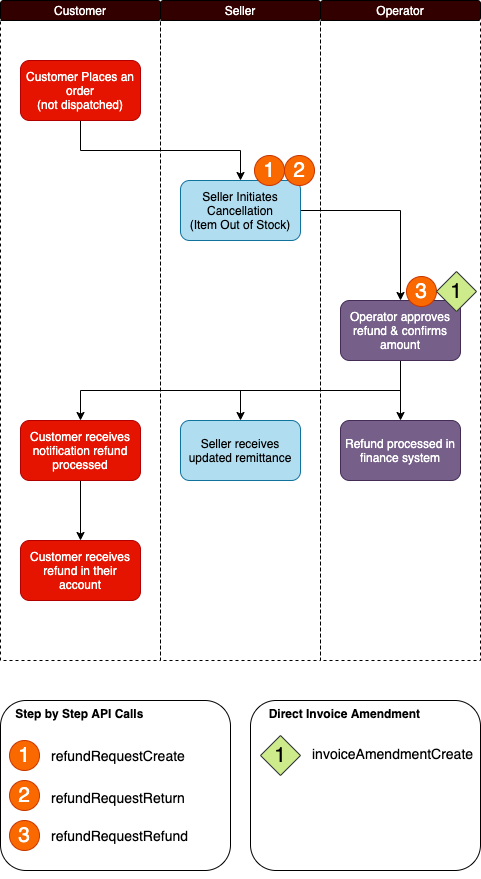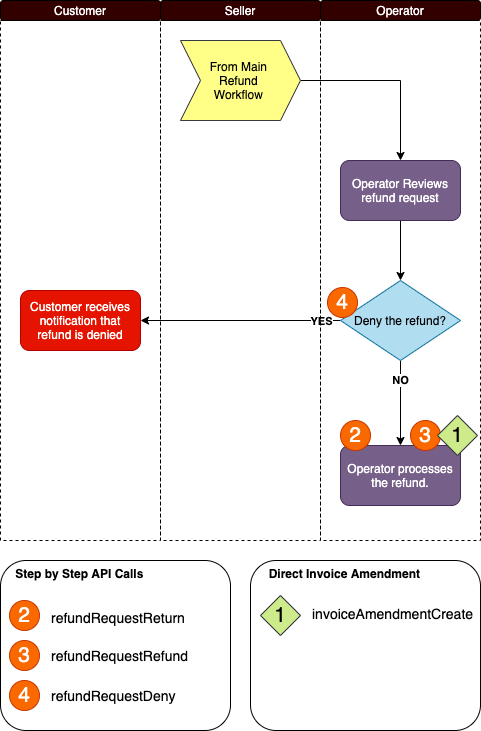How to use the refunds flow
4 minute read
What you’ll learn
In this how to we take you through how to perform returns and invoice amendments with GraphQL, we cover:
- Key concepts and terms
- Processes for returning (& refunding)
- The GraphQL API calls you’ll need to make
IMPORTANT
This article outlines the original refunds workflow. The original flow has been superseded by the Advanced Refunds workflow which is now the default. For existing customers that have not been migrated to the advanced workflow, this can be done on request via your Marketplacer point of contact, otherwise you can continue to use the original flow as documented in this article.Key Terms
Before launching into the processes that can be followed, it’s worth clarifying the language and terms used when we talk about refunds and returns.
| Term | Description |
|---|---|
| Cancellation (Process) | Cancellation occurs before purchased items are dispatched. So for example, a Seller may wish to cancel the order if they have run out of stock. |
| Return (Process) | This is the term we use when an order has been dispatched, and the customer wishes to return it for a refund. An example of this is that the item did not meet the customers expectations and they do not want a replacement. Note: the “successful” outcome of the return process will result in the return of the item and a refund of money. |
| Exchange (Process) | The Exchange process occurs when the order has been dispatched and the Customer wishes to swap (exchange) it for another item. For example the dispatched item was faulty, and the customer would like a replacement. Exchanging is not currently supported. |
| Refund Request (Entity) | A Refund Request is created when either the Cancellation or Return process is initiated. It is the primary vehicle used to manage the lifetime of this request. A successful Refund Request will ultimately result in an Invoice Amendment. |
| Invoice Amendment (Entity) | An Invoice Amendment will be made to a customer invoice if there needs to be any kind of adjustment following a successful Refund Request, (either the Cancellation or Return process). Note that an Invoice Amendment can be created directly on an Invoice without needing to create a Refund Request, (“short circuiting the process”). |
| Headless | A headless Marketplacer deployment is where the marketplace operator has chosen not to use the Marketplacer customer-facing store, instead opting for their own front end. Note: the Operator and Seller Portals are still in use. |
| Full-stack | A full-stack Marketplacer deployment is where the marketplace operator has opted to use the full functionality of the Marketplacer stack, including the customer-facing Marketplacer front end. |
Processes
In the section that follows we outline the process flows for:
- The Cancellation workflow
- The Return workflow
- The Deny workflow
In all cases we overlay with the relevant API calls that can be made at each step. The reader should note that they can use either the Direct Invoice Amendment approach or the Step by Step Approach (the step by Step approach ultimately results in an Invoice Amendment)
Cancellation Process
The Cancellation Process occurs when an order has not yet been dispatched.

Return Process
The Return Process occurs when an order has been dispatched.

Deny Process
The Deny Process follows on from the Return Process

API Calls
It is advised that the reader refer to either the Full Reference Documentation or GraphQL Voyager for the latest information relating to the API Calls referenced in this document. Note, both sources present the same schema, (with associated documentation), but using different formats / presentation styles.
However for reference, a summary of the calls have been provided below:
| API | Description | Results In… |
|---|---|---|
| refundRequestCreate | Initiates either the Cancellation or Return Process | Results in the Creation of a RefundRequest with the Status of: AWAITING |
| refundRequestReturn | Acknowledges the Return of Items | Results in the the status of the RefundRequest being updated to: RETURNED |
| refundRequestRefund | Finalizes either the Cancellation or Return Process | Results in the status of the RefundRequest being updated to: REFUNDED, also results in the creation of an InvoiceAmendment |
| refundRequestDeny | Used to deny a Refund Request | Results in the the status of the RefundRequest being updated to: DENY |
| updatedRefundRequests | Used to return all Refund Requests updated from a given timestamp | Results in a object array of Refund Requests (which can be empty) |
| invoiceAmendmentCreate | Used to directly amend an invoice without the need to go through the step by step flow. | Results in an amended Invoice with associated InvoiceAmendment record. |
Considerations
Return & Refund processes are complex and fraught with nuance, with this in mind we have provided some additional considerations for the reader:
- The Seller Portal will be in use even for Headless deployments, so a Refund Request can be generated by a Seller using this option. Therefore while consumer initiated returns will be managed by the operators front end, seller initiated returns can be generated via this path and will need to be considered as part of the overall Return Process.
- Webhooks can be employed in addition to the API’s outlined above to provide event-based notifications on Refund Requests. You can read more about webhooks here.